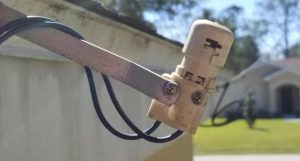The first day of summer was June 21, which also happens to be the longest day of the year. The weather has been oppressively hot and humid. Scattered thundershowers have become an almost daily occurrence, creating less time to tackle the weekly chore of mowing. The UF/IFAS Flagler County Extension office has been inundated with seasonal calls for turf related issues. The wet conditions are a recipe for pathogens including fungi. Consider changing cultural practices as a first line of defense. Water should only be applied to turf as needed. However, we can’t control how much water is supplied in the form of rainfall by nature. The University of Florida recommends that you do not apply irrigation within 24 hours before or after a significant rain event. Right now most lawns in Flagler County would benefit from drying out. Depending on your yard’s drainage it may take several days to weeks to dry out from heavy rains. Now might be a good time to shut off your irrigation completely. Residents should pay attention to their turf and let it tell them when to water. Grass that needs water begins to slightly wilt and the leaf blades begin to fold. Turf that is ready to be irrigated will also begin to have greyish blue color and foot prints will remain visible when walked on. Grass that is watered properly will have deeper roots and will be more resistant to pests and disease. Irrigation system setting should be adjusted gradually over time to accommodate the lawn’s current water needs. Check that irrigation systems are working correctly, especially the automatic rain shutoff sensor.  The automatic rain shutoff sensor should be set to ½ to ¾ of an inch, based on UF/IFAS recommendations. The system can be tested by attempting to manually turn on your sprinkler timer during a rain event after ½ or ¾ of an inch has fallen. If the sprinklers come on, the irrigation system automatic rain shutoff sensor needs to be adjusted or repaired. The most common rain sensor type utilizes an expandable cork that swells when exposed to moisture, breaking a connection and shutting off the system. The inner cork wears out over time and should be checked seasonally for proper function. For more information visit http://edis.ifas.ufl.edu/ae221 “Residential Irrigation System Rainfall Shutoff Devices.”
The automatic rain shutoff sensor should be set to ½ to ¾ of an inch, based on UF/IFAS recommendations. The system can be tested by attempting to manually turn on your sprinkler timer during a rain event after ½ or ¾ of an inch has fallen. If the sprinklers come on, the irrigation system automatic rain shutoff sensor needs to be adjusted or repaired. The most common rain sensor type utilizes an expandable cork that swells when exposed to moisture, breaking a connection and shutting off the system. The inner cork wears out over time and should be checked seasonally for proper function. For more information visit http://edis.ifas.ufl.edu/ae221 “Residential Irrigation System Rainfall Shutoff Devices.”
Take into account site conditions and annually recurring issues in the same locations. The soil used for fill during home construction in yards may lack uniformity or have issues with drainage in certain areas due to geography, landscape design, and downspout locations. Poorly drained areas may require less irrigation or in some instances none at all. Consider capping heads in areas that are excessively wet. Dollar weed is a good indicator overly wet turf. Isolated seasonally saturated portions of the yard may be a good location to create a rain garden planted with plants well adjusted for moist conditions. For more information visit http://edis.ifas.ufl.edu/ep479 “Soil Characteristics and Management Practices for Urban Residential Landscapes”
 Another common issue is mowing grass too short, also known as scalping. This can contribute to lawn stress and cause a patchy appearance. Mower blades should be sharpened so that they cut rather than tear the grass leaf blade. Lawns should also be mowed at the highest acceptable height for the type of grass. As a general rule don’t remove more than 1/3 of the leaf blade at a time. For specific grass type mowing heights visit http://edis.ifas.ufl.edu/lh028 “Mowing Your Florida Lawn”.
Another common issue is mowing grass too short, also known as scalping. This can contribute to lawn stress and cause a patchy appearance. Mower blades should be sharpened so that they cut rather than tear the grass leaf blade. Lawns should also be mowed at the highest acceptable height for the type of grass. As a general rule don’t remove more than 1/3 of the leaf blade at a time. For specific grass type mowing heights visit http://edis.ifas.ufl.edu/lh028 “Mowing Your Florida Lawn”.
When it comes to turf, a dense healthy lawn is more resistant to disease and weeds. Fertilizer/ herbicide combination products are not suggested by the University of Florida because they can cause damage to landscape trees and shrubs that have roots underneath turf. Weeds usually occur in the open patches in your lawn. Fill these patches with grass plug pieces of the same species of grass. Fertilize with the correct recommended amount of slow release fertilizer while turf is actively growing. Applying fertilizer before a heavy rain will likely result in nutrients being carried away along with stormwater, potentially contributing to surface and groundwater pollution. For additional information visit http://edis.ifas.ufl.edu/pdffiles/LH/LH01400.pdf “General Recommendations for Fertilization of Turfgrasses on Florida Soils”
Sol Looker is the Residential Horticulture Extension Agent and Master Gardener Coordinator at the Flagler County Extension Service, University of Florida. For more information contact the office, (386) 437-7464. The Extension Service is located at 150 Sawgrass Road Bunnell, Florida 32110.
 0
0
